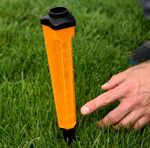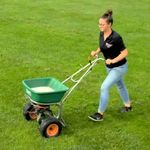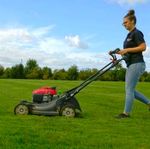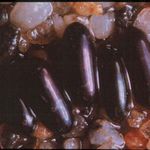Managing Crane Fly in Lawns - Adult crane flies are a - OSU Extension Catalog
←
→
Page content transcription
If your browser does not render page correctly, please read the page content below
OREGON STATE UNIVERSIT Y EXTENSION SERVICE
Managing Crane Fly in Lawns
A. Kowalewski, B. Edmunds,
B. McDonald and E. Braithwaite
A
dult crane flies are a
common sight in Pacific
Northwest summers.
You see them bouncing around
walls and ceilings, or stuck in
spiderwebs, long legs and wings
tangled. The size and shape of
these insects have earned them
nicknames like “mosquito hawk”
and “skeeter eater,” but they do
not consume mosquitoes. Their
larvae, however, are known for
eating the roots and shoots of
your lawn. Learn how to identify
crane flies and prevent damage —
months before it shows up as bare
patches in your yard.
There are several species of crane
fly in the Pacific Northwest, but
only the marsh crane fly (Tipula
oleracea) and the common European
crane fly (Tipula paludosa) damage
turfgrass. Both these crane flies are
invasive species, native to Europe and Photo: Alec Kowalewski, © Oregon State University
northern Africa, and now widespread An adult crane fly emerges from the grass in late summer.
across much of North America.
The common European crane fly was first detected can cause extensive damage to lawns because the
in Western North America in 1965. The marsh crane insects feed on the turfgrass faster than it can grow.
fly was not found in the Pacific Northwest until more European crane fly larvae feed on turfgrass shoots,
recently. The marsh crane fly has multiple generations crowns and roots, causing substantial damage in early
a year, while the common European crane fly has spring. Proper turfgrass management can substantially
only one generation a year. Both crane fly species are reduce the damage caused by this insect. In cases of
commonly referred to as European crane flies, due extreme infestations, scouting and properly timed
to their similarity in origin and appearance, and the insecticide applications can prevent turfgrass losses.
damage they cause. These insects prefer regions that
receive substantial precipitation. They can be found
Alec Kowalewski, Extension turf specialist and associate professor;
throughout British Columbia, Washington, Oregon Brooke Edmunds, Extension community horticulturist and assistant
and northern California. More recently, outbreaks have professor; Brian McDonald, senior faculty research assistant; and
occurred in Bend and in Spokane, Washington. Emily Braithwaite, faculty research assistant; all of the Department of
The winter larval stage of these European crane flies Horticulture, Oregon State University.
EM 9296
September 2020Photo: Alec Kowalewski, © Oregon State University Photo: Alec Kowalewski, © Oregon State University Photo: Alan Dennis, © Oregon State University
EGGS: Deposited in mid-September LARVAE: Survive best in rainy fall weather. ADULTS: Live only about one month.
Identification, life cycle and damage
The adult European crane fly is a delicate-bodied underground from early October until the following
insect about 1 inch long. It has two functional wings and September — 11 months of the year. They are large,
a pair of specialized smaller wings called halteres — a grey, legless maggots with finger-like appendages on
characteristic distinctive of the order Diptera. Adult the posterior end and no well-defined head. These
European crane flies are tan in color, have a long, thin larvae are often referred to as “leatherjackets.” They
abdomen, and have wings and legs that stretch the reach their maximum size (1 to 1.5 inches long) in
length of the abdomen. December and cause the greatest damage to the shoot,
crowns and roots of grass plants in spring.
The winter life cycle begins with adult insects that
live above ground for the first two weeks in September. Aboveground symptoms include thinning turfgrass
During this time, insects are focused on reproduction. beginning in February, progressing to total loss of
They do not feed, but they do drink water. Adult crane turfgrass in April and May in wet, low-lying areas. Birds,
flies lay their eggs in low-lying areas with high soil skunks and raccoons will often forage for the larvae
moisture, often next to waterways, in mid-September. in infested areas, causing further damage. In extreme
cases, populations reach levels capable of completely
The winter generation of European crane fly hatch destroying a lawn. In these instances, the larvae often
in early October. Both eggs and young larvae survive move across the soil surface in search of more grass to
best when fall conditions are rainy. The larvae live consume.
Photos: Alec Kowalewski, © Oregon State University
DAMAGE: European crane fly infestations often appear as thinning turfgrass. In extreme cases, larvae can completely destroy a lawn.
2Photo: Alan Dennis, © Oregon State University Photo: Stephen Ward, © Oregon State University Photo: Alan Dennis, © Oregon State University
MOWING: Once a week. IRRIGATING: 0.25 inches four times a week. FERTILIZING: Follow recommended rates.
Management
The key to managing crane fly is maintaining healthy turfgrass. Follow these recommendations for mowing,
watering and fertilizing, and address any drainage issues. Scout for crane fly, and base the use of insecticides on
scouting results. Start with cultural management: Properly maintained turfgrass growing in well-drained soil is more
resistant to crane fly damage. To keep your lawn healthy, regularly mow, fertilize and irrigate in summer.
See Practical Lawn Care for Western Oregon, EC 152, https://catalog.extension.oregonstate.edu/ec1521.
Mowing Fertilizing
Mow once a week to a height of 2 to 3 inches. Return Perennial ryegrass, which is used west of the
the grass clippings to the lawn to reduce the need for Cascades, and Kentucky bluegrass, which is used east
fertilizer. of the Cascades, should also receive two fertilizer
applications in the spring (around the end of May
Irrigating and June) and two applications in the fall (around the
Apply 0.25 inch of water four times per week (a total end of September and October) (Table 1). Fertilizer
of 1 inch), from Memorial Day to Labor Day. You may for turfgrass should have high levels of nitrogen, low
need to adjust this amount based on current weather levels of phosphorus and moderate levels of potassium
and soil conditions. Frequent summer irrigation is key (sample ratio 25–5–10 N–P–K).
when trying to maintain turfgrass affected by European
crane fly. The crowns and root systems, which were Table 1. Fertilizer rates
damaged the previous winter and spring, need regular Pounds of nitrogen (N) per 1,000 square feet of turfgrass
water to recover.
Type
Spring Fall Total
Improving soil drainage of grass
Improving soil drainage will also reduce European Perennial 2 applications 2 applications 4 lbs
crane fly populations. Eggs and young larvae survive ryegrass of 1 lb each, of 1 lb each,
best when developing in wet soil, so dry conditions West of the late May and late September
at this stage will increase mortality. Installing French Cascades late June and late
drains and drain tiles with a catch basin or drywell can October
substantially improve saturated soil conditions. Reduce
moisture by stopping irrigation, or irrigating less Kentucky 2 applications 2 applications 4 lbs
frequently, around Labor Day. In early September, adult bluegrass of 1 lb each, of 1 lb each,
European crane flies search for wet soil in which to East of the late May and late September
lay their eggs. Turning off or reducing irrigation at this Cascades late June and late
time will keep the adults from laying eggs and reduce October
egg survival. Turfgrass needs less water at this time of
the year, when days are shorter and weather is cooler. Tall and 1 lb 1 lb 2 lbs
Reducing irrigation at this time is unlikely to stress fine fescue
turfgrass.
3Photo: Alec Kowalewski, © Oregon State University
SCOUTING: Look for crane fly in areas where turfgrass is thinning. Use a square-end shovel to dig up a section of sod. Flip it upside down
and count the number of larvae per square feet.
Scouting
Scout for European crane fly in November, December Insecticide licenses and labels
and January. This is when larvae are reaching maturity, The purchase and use of some of these
but before significant damage has occurred. Scout insecticides may require a state-issued applicator’s
in low-lying areas where water tends to pool on the license. Be familiar with all state laws governing
surface, or where the soil is often close to saturation. pesticide use. Carefully read and follow label
Because of these favorable environmental conditions, directions, including the application rate, timing,
adults will often return to the same areas each personal protective equipment, mixing, loading and
September to lay their eggs. That’s why you should intended use. The label is the law.
scout in areas of previous damage. Larval survival can
vary widely from year to year based on moisture level,
bird predation and other factors, so continue scouting Spring applications will not prevent damage, because
previous problem areas even after a year has passed. by then the majority of turfgrass destruction will
have already occurred. Applying insecticide in winter
Areas of thinning turfgrass and damage by birds
will also substantially reduce the risk of exposing
and other foraging animals are clues that suggest high
pollinators such as honey bees and butterflies. These
larval populations. In these areas, use a square-end
insects actively forage in spring and summer, when
shovel to dig up a section of sod 1 foot long, 1 foot
plants are in bloom and temperatures are warm.
wide and 1 inch deep. Flip the sod layer upside down
and inspect the soil for larvae. If you find more than If using insecticides that are toxic to bees, don’t
25 larvae per square feet in well-maintained turfgrass, apply them when weeds and flowers are blooming in
take action. and around lawns. Winter applications will provide
optimum European crane fly control and substantially
Using insecticides reduce the risk of pollinator exposure.
Proper cultural practices — mowing, irrigation, After applying an insecticide to manage European
fertilization and efforts to improve soil drainage — crane fly, continue to scout for damage and larvae. You
come first. If you’ve addressed those issues and still may need to make repeated applications over several
count large populations of larvae (exceeding 25 per years for complete control. For more details on suggested
square foot), insecticides can help manage crane fly insecticides and specific usage rates, refer to the Pacific
infestations (Table 2, page 5). For best results, apply Northwest Insect Management Handbook (https://
them in the winter months, before you see damage. pnwhandbooks.org/insect) and the insecticide label.
4Table 2. Insecticides for use against European crane fly
Active ingredient Commercial Action word EPA carcinogen Home Restricted Toxicity
products Human toxicity* classification lawn use
use For licensed
applicators
Chlorantraniliprole Acelepryn No signal word Not likely x Toxic to aquatic
a human organisms
carcinogen
Esfenvalerate Conquer Caution Evidence of x Toxic to aquatic
noncarcinogen organisms; very toxic
in humans to bees
Imidacloprid Adonis, Caution Evidence of x Not very toxic to birds;
Malice, noncarcinogen slightly toxic to fish
Mallet, in humans and aquatic organisms;
Merit very toxic to bees and
other insects.
Bifenthrin Talstar Caution Possible human x Low toxicity to birds;
carcinogen highly toxic to fish,
aquatic organisms and
bees
Carbaryl Sevin Caution Likely a human x Practically nontoxic or
carcinogen slightly toxic to birds;
slightly to moderately
toxic to mammals;
moderately to highly
toxic to fish; highly
toxic to earthworms
and bees; very highly
toxic to shrimp, water
fleas and stoneflies.
Clothianidin Arena Caution Not likely x Toxic to aquatic
a human organisms; very toxic
carcinogen to bees
Indoxacarb Provaunt Caution Not likely x Toxic to aquatic
a human organisms; highly toxic
carcinogen to bees
Thiamethoxam Meridian, Caution Not likely x Toxic to mammals;
Flagship a human highly toxic to aquatic
carcinogen organisms and bees
Chlorpyrifos Dursban, Danger Evidence of x Very toxic to
Hatchet, noncarcinogen moderately toxic to
Vulcan, in humans birds, depending on
Warhawk the species; very toxic
to fish and aquatic
organisms; very toxic
to bees; toxic to
earthworms
* Expressed as a range from “no signal word” to “caution,” “warning,” “danger” and “danger — poison.”
5Photo: Alec Kowalewski, © Oregon State University
Crane flies mating. Adult crane flies live above ground for the first two weeks of September.
References and resources
Hollingsworth, C.S. 2019. Pacific Northwest Insect Management Handbook. Turfgrass-Crane fly: European Crane Fly
and Common Crane Fly. https://pnwhandbooks.org/insect/hort/turfgrass/turfgrass-crane-fly
How to Reduce Bee Poisoning from Pesticides, PNW 591, http://catalog.extension.oregonstate.edu/pnw591
Practical Lawn Care for Western Oregon, EC 1521, http://catalog.extension.oregonstate.edu/ec1521
This publication will be made available in an accessible alternative format upon request. Please contact puborders@oregonstate.edu or
1-800-561-6719.
© 2020 Oregon State University. Extension work is a cooperative program of Oregon State University, the U.S. Department of
Agriculture, and Oregon counties. Oregon State University Extension Service offers educational programs, activities, and materials
without discrimination on the basis of race, color, national origin, religion, sex, gender identity (including gender expression),
sexual orientation, disability, age, marital status, familial/parental status, income derived from a public assistance program, political
beliefs, genetic information, veteran’s status, reprisal or retaliation for prior civil rights activity. (Not all prohibited bases apply to all
programs.) Oregon State University Extension Service is an AA/EOE/Veterans/Disabled.
Published September 2020
6You can also read



























































